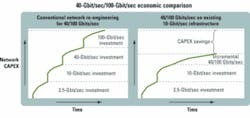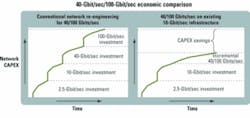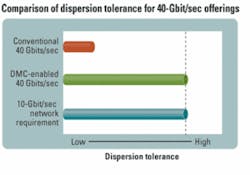How to deliver 40 and 100 Gbits/sec on 10-Gbit/sec optical networks
by Andres Viera
Service providers are facing a challenge. They have revenue-generating opportunities from bandwidth-intensive services driven by video, yet their networks are nearing saturation. Although they have recently completed re-engineering their metro/regional optical networks to support 10-Gbit/sec wavelengths, there is now a need for yet another round of major network re-engineering to increase their bandwidth capacity at a time when capital budgets are being cut.
The conventional wisdom that suggests building more networks and installing new fibers to increase bandwidth capacity is not only very capital-intensive, but also requires considerable planning and engineering cycles. At the rate that services are expanding and the demand for bandwidth is exploding, service providers have realized that the conventional network build approach is unsustainable because it leads to an unprofitable business model. They need a way for service bandwidth to be added quickly to satisfy service demands, and at the same time remain within a constrained capital situation that requires matching service revenue with network investment. To satisfy these requirements, the best bandwidth expansion approaches must economically maximize and incrementally scale bandwidth while maintaining compatibility with existing embedded network infrastructure and deployed 10-Gbit/sec wavelengths.
For service providers to profitably deploy new bandwidth-intensive services, optical networks expansion should follow these key criteria:
- Accommodate rapid service growth: Service providers must deploy new bandwidth rapidly to meet customer requirements for bandwidth-intensive services. In addition to being capital-intensive, the installation of more fiber and network equipment is a lengthy, labor-intensive process that involves extensive time and effort for engineering, planning, and tuning, as well as administrative overhead. Rapid service growth requires expanding the bandwidth capacity of existing optical networks. Furthermore, it is critical that this bandwidth expansion be accomplished without costly network downtime. Incremental service scaling to match revenue with investment: Capacity should be expandable from 10 to 40 Gbits/sec on a wavelength-by-wavelength basis. This enables service providers to increase bandwidth according to service revenue and avoid the historical requirement to make capital investments in advance of service revenues.Maximize bandwidth capacity of existing optical infrastructure: Service providers must be able to derive maximum service revenue from their installed fiber networks. This requires that the optical networking systems deliver high spectral efficiency, or bandwidth capacity per fiber. Advanced, high-performance optical networking systems can deliver service capacity of up to 8 Tbits/sec per fiber in the C-Band, ensuring lowest cost per unit of service capacity.Continuing cost reduction per service bandwidth: Competition among service providers continues to drive service prices lower, putting considerable pressure on carriers� revenue and net income. The network infrastructure must be able to take advantage of economies of scale and advancements in technology integration to reduce network costs. The opportunity exists to leverage the mature, reliable 10-Gbit/sec component ecosystem to incrementally deliver lower cost per service bandwidth on existing networks.
Figure 1 illustrates the economic imperative of supporting 40 and 100 Gbits/sec on existing 10-Gbit/sec optical networks. The diagram on the left shows the network capital expenses that result from the conventional approach of continuously building the network infrastructure to accommodate more bandwidth per channel�from 2.5 Gbits/sec, to 10 Gbits/sec, now to 40 Gbits/sec, and later to 100 Gbits/sec�in advance of service revenues. This approach is similar to constructing roadways to add new lanes and hoping toll revenues will cover the cost.
Conversely, the right section of Fig. 1 illustrates the resulting savings from using existing 10-Gbit/sec networks for 40- and 100-Gbit/sec wavelengths without the need for network re-engineering. Savings will be even greater in a fiber exhaust situation, where additional investment in new fiber plant would be required. It is not uncommon for economics, right-of-way restrictions, or other reasons to eliminate the option of installing new fiber entirely.
To meet the continued demands for service revenue and profits, optical networks must provide 40- and/or 100-Gbit/sec wavelengths that are compliant with 10-Gbit/sec engineered networks. Such compliance has several aspects, all of which must be addressed for incremental upgrade to 40 and 100 Gbits/sec to be fully effective:
• Compatibility with 10-Gbit/sec network topology: 40- and 100-Gbit/sec wavelengths must be supported on the same links and distance as 10 Gbits/sec, without requiring fiber replacement or additional dispersion compensation equipment. Metro networks frequently use cascaded ROADMs, resulting in bandwidth narrowing issues. Wavelengths at 40 and 100 Gbits/sec must pass transparently through the narrowed bandwidth of ROADM-intensive topologies.
• Compatibility with 10-Gbit/sec wavelengths and installed network elements: Incremental upgrade to 40 and 100 Gbits/sec requires that these wavelengths co-exist with 10-Gbit/sec wavelengths on adjacent channels. If any wavelengths need to remain unoccupied to serve as â��guard bands,â�� maximum fiber capacity will not be attained and overall costs will be higher. It is important to avoid swap-out of existing equipment, which requires that 40- and 100-Gbit/sec wavelengths be able to be injected into installed 10-Gbit/sec network elements. This is commonly referred to as â��alien wavelength injection.â��
• Compatibility with future wavelength evolution: Bandwidth-intensive services are clearly expected to grow significantly into the future, and optical network bandwidth expansion must keep pace. The move to 40-Gbit/sec wavelengths is an important step on the path toward bandwidth expansion, but is not the end-point on that path. Technology for 40-Gbit/sec wavelengths must be compatible with future requirements for 100-Gbit/sec wavelengths and even higher.
• Compatible with cost, power consumption, space, and complexity limitations: To be successfully and economically deployed, 40- and 100-Gbit/sec technology must not only offer low first cost, but also be comparable with installed 10-Gbit/sec hardware in terms of space and power requirements to avoid costly upgrade of physical facilities. In addition, it is important that 40- and 100-Gbit/sec platforms be simple to operate and not require extensive labor for planning, engineering, and routine network diagnostics and operations.
The conventional 40- and 100-Gbit/sec options proposed to date typically use high transmission (baud) rates on the optical line and do not meet the requirements described above for expanding the bandwidth capacity of 10-Gbit/sec engineered optical networks. This presents a number of technical challenges in terms of interoperating with existing fiber plants and requires service providers to make performance compromises as well as incur capital and operational costs.
For example, some proposed approaches use a modulation format that conflicts with the non-return to zero (NRZ) modulation of 10-Gbit/sec networks, which means that 40-Gbit/sec wavelengths operating on adjacent channels with 10-Gbit/sec wavelengths require wasteful spectrum guard bands. Other proposed methods are sensitive to dispersion. These approaches cannot be operated cost-effectively on existing optical links because they require more frequent signal regeneration than the installed 10-Gbit/sec networks currently provide.A common problem with conventional 40-Gbit/sec technologies is that they occupy a wide spectrum within the ITU standard window. This pre-sents severe difficulties in using them on optical networks that include cascaded ROADMs (typical of metro optical networks) because the resulting bandwidth-narrowing effect attenuates the optical signal at the extremes of the channel and causes distortion. Similarly, conventional 40-Gbit/sec approaches are hard to use successfully with certain types of installed optical filters due to the same kind of bandwidth narrowing effects.
The most challenging limitation of conventional 40-Gbit/sec approaches, however, is their poor tolerance for chromatic dispersion (CD) and polarization-mode dispersion (PMD). For 40-Gbit/sec and 100-Gbit/sec transmissions, PMD is a particularly critical issue because system tolerance not only decreases as the data rate increases, but PMD also is highly temperature- and vibration-sensitive, which makes it difficult to mitigate. The PMD characteristics of a fiber may depend on its date of manufacture and type of installation (aerial versus underground) and may vary according to ambient temperature and physical stress.
Field data demonstrates that the PMD characteristics of many legacy fibers are too high to support 40 Gbits/sec using conventional modulation approaches, let alone 100 Gbits/sec. As a result, attempting to deploy conventional 40-Gbit/sec technologies on existing fiber requires costly and time-consuming characterization in the field along with costly and unreliable adaptive dispersion compensation equipment. Consequently, the service provider suffers from significant capital investment and delay, which compromises its ability to keep up with fast-growing bandwidth demands.
Clearly the best approach for service providers is to maximize the life of their existing network investment and incrementally grow bandwidth on installed 10-Gbit/sec networks with spectrally efficient 40-Gbit/sec and then 100-Gbit/sec wavelengths as new services are deployed. This approach is more economically acceptable because it directly couples network investment to service revenue in the manner that has proven successful for broadband access networks. A new generation of high-performance optical technology is emerging that achieves these goals.
Emblematic of this new wave of technology is dense multi-carrier (DMC) technology, which supports 40- and 100-Gbit/sec wavelengths on today�s 10-Gbit/sec networks without the compromises of conventional approaches. DMC combines densely packed multiple carriers with multiple-level modulation techniques to enable any installed 10-Gbit/sec network to support 40- and 100-Gbit/sec wavelengths on an incremental basis, without the need for new fibers or re-engineering existing fiber plants.
DMC ensures compatibility with 10-Gbit/sec networks by delivering 40- and 100-Gbit/sec data rates using the same 10-Gbit/sec symbols/sec transmission rate used by 10-Gbit/sec networks. DMC-enabled wavelengths look and operate like conventional 10-Gbit/sec wavelengths to the network but deliver services at 40 and 100 Gbits/sec in the same spectrum. The result is that DMC meets all the requirements for incrementally upgrading 10-Gbit/sec networks.
As illustrated in Fig. 2, DMC�s 10-Gbit/sec transmission rate delivers the same high tolerance to dispersion as 10-Gbit/sec networks, ensuring any 10-Gbit/sec network can support 40- and 100-Gbit/sec services. This is the key to ensuring reliable 40- and 100-Gbit/sec operation on existing fiber plants without re-engineering or additional dispersion compensation equipment.
DMC uses a modulation scheme that is compatible with the NRZ modulation 10-Gbit/sec networks use, which enables service providers to grow network capacity incrementally by replacing individual 10-Gbit/sec wavelengths with 40- or 100-Gbit/sec upgrades with no impact on adjacent 10-Gbit/sec traffic. Modulation compatibility thus preserves the maximum bandwidth capacity of the fiber.
The combination of DMC�s modulation compatibility with its well-controlled spectrum enables 40- and 100-Gbit/sec channels to be injected as alien wavelengths into existing optical network elements. This is a significant advantage in that the wavelengths can be mixed on the same fiber as 10-Gbit/sec wavelengths, providing significant flexibility in planning and supporting incremental services growth as customer demand dictates. DMC therefore represents an open system technique that operates gracefully with installed optical equipment and facilitates economical deployment of 40- and 100-Gbit/sec wavelengths without large-scale equipment replacement.
Fundamentally, the best vehicle for delivering more service bandwidth is the one that meets the key performance requirements at the lowest cost. The conventional approaches to 40-Gbit/sec wavelengths in the marketplace have forced service providers to compromise and subsequently have proven uneconomical. The conventional technology may conceivably mature in the next several years and the supply chain may develop to support better performance and price. However, these lower-volume approaches face significant challenges in continuously competing with the embedded 10-Gbit/sec ecosystem that is continuing to integrate and expand in volume, further driving steep year-over-year cost reductions.
DMC leverages the 10-Gbit/sec optical ecosystem of low-cost, reliable, mature components available in high volumes, and is based on a simple, robust architecture.
The result is a universal optical approach to 40 Gbits/sec and 100 Gbits/sec that is deployable today with the lowest network lifecycle costs for continuing operation.
Andres Viera is director of technical marketing at OpVista Inc. (www.opvista.com).


